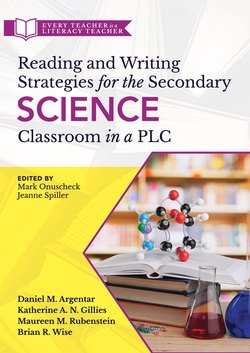Читать книгу Reading and Writing Strategies for the Secondary Science Classroom in a PLC at Work® - Daniel M. Argentar - Страница 5
На сайте Литреса книга снята с продажи.
ОглавлениеTABLE OF CONTENTS
Reproducible pages are in italics.
About the Series Editors
About the Authors
Preface
INTRODUCTION
Every Teacher Is a Literacy Teacher
The Need for Literacy Instruction
Disciplinary Literacy
About This Book
Wrapping Up
CHAPTER 1
Collaboration, Learning, and Results
Collaboration Within a PLC
Collaborative Meeting Logistics
Standards Analysis and Goal Setting
Identification of Students’ Literacy Skills
Identification of the Content-Literacy Connections
Wrapping Up
CHAPTER 2
Foundational Literacy Triage
Understanding Response to Intervention
Differentiating Instruction
Assessing the Level of Text Complexity
Using Fix-Up Strategies
Considerations When Students Struggle
Considerations When Students Are Proficient
Wrapping Up
CHAPTER 3
Prereading
The Importance of Prereading
Collaboration Around Prereading Activities
The Four Ps of Science Prereading
NGSS Connections
Strategies for Supporting Students in Prereading
Considerations When Students Struggle
Considerations When Students Are Proficient
Wrapping Up
CHAPTER 4
During Reading
The Need for Engaged, Active Readers
Collaboration Around During-Reading Activities
NGSS Connections
Strategies for Supporting Students During Reading
Considerations When Students Struggle
Considerations When Students Are Proficient
Wrapping Up
CHAPTER 5
Postreading
The Importance of Postreading Instruction
Collaboration Around Postreading Activities
NGSS Connections
Strategies for Supporting Students in Postreading
Considerations When Students Struggle
Considerations When Students Are Proficient
Wrapping Up
CHAPTER 6
Writing
Collaboration Around Consistent Language
NGSS Connections
Strategies for Supporting Students in Writing
Considerations When Students Struggle
Considerations When Students Are Proficient
Wrapping Up
CHAPTER 7
Assessment
Understanding the Role of Literacy-Based Assessment in the Science Classroom
Matching Text Complexity and Reader Capacity
Monitoring Student Perceptions
Collaborating to Create Assessments
Using Rubrics as Assessment Tools
Providing Timely and Effective Feedback
Analyzing and Applying Data
Wrapping Up
Epilogue
Appendix: Reproducibles
Frayer Model Template
Recalling Previous Reading to Prepare for New Learning
Activating Background Knowledge Strategy
Anticipation Guide
Predicting and Confirming Activity
Text-Dependent Questioning Graphic Organizer
Simple T-Chart for Taking Notes
Expanded Information Chart to Extend Thinking
Five Words Recording Sheet
Self-Questioning Tool
Sample Two-Paragraph Template
Evaluating Claim Statements and Supporting Them With Evidence
Rubric to Provide Timely and Effective Feedback
References and Resources
Index
